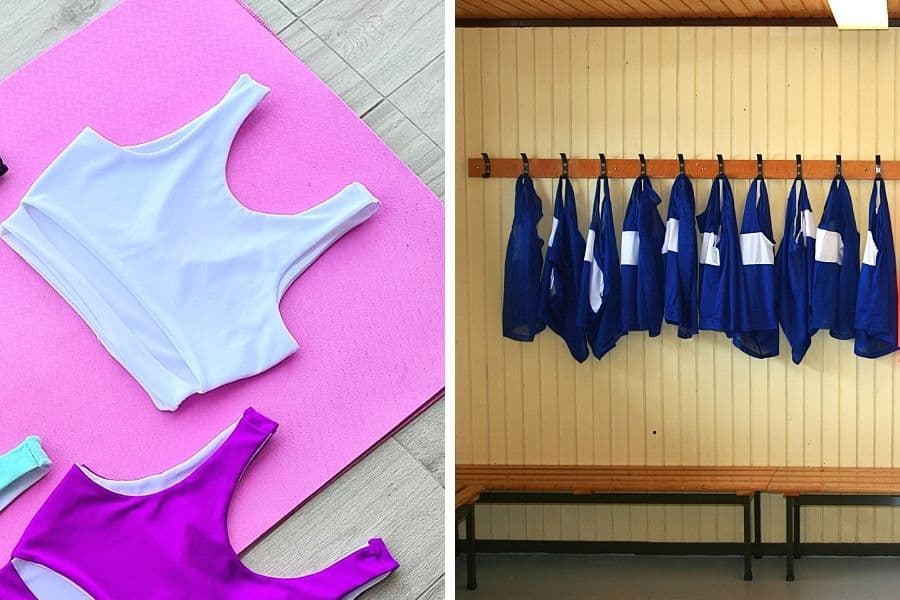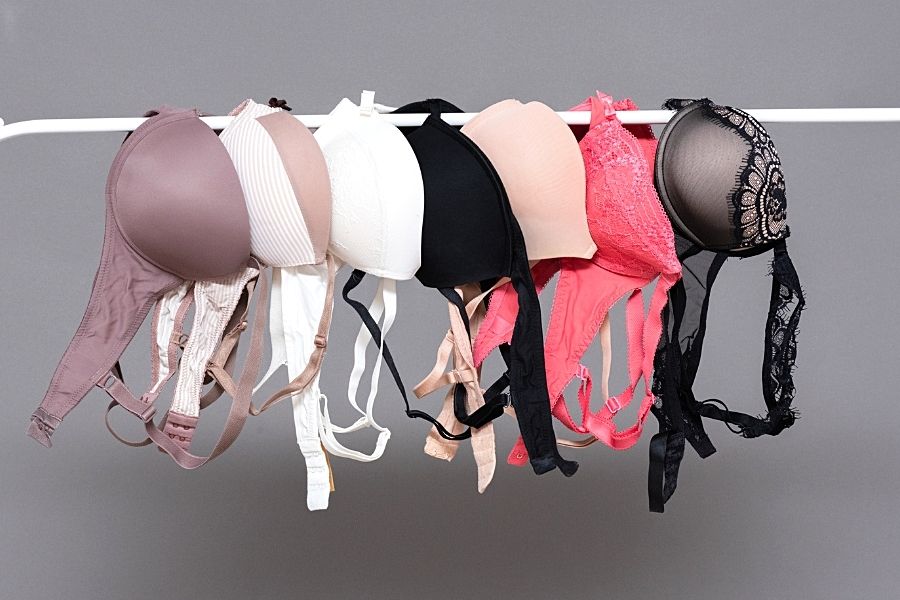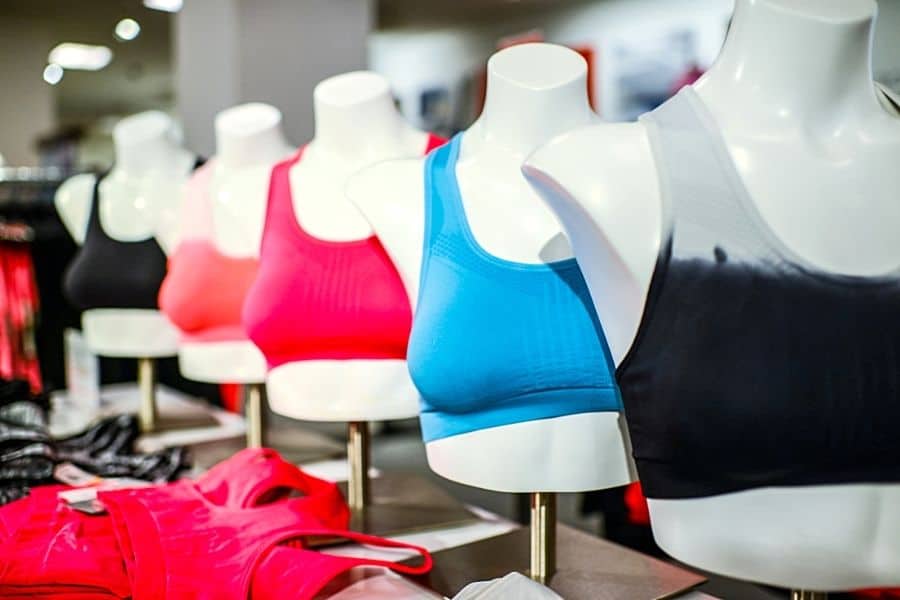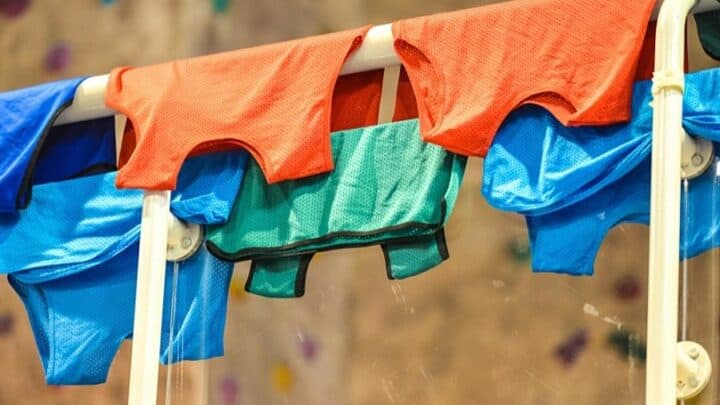Soccer players don’t wear bras, thank you very much! I’m a soccer player, and I’m sure neither me or my teammates wear bras!
If a jockstrap is a “lower decker knacker strapper,” then a bra is an “upper decker flopper stopper“, and being sturdy, muscular young men… well, muscular men… okay, that’s just men; still, we don’t have jiggly bits that need “stopping from flopping.”
Now that I’ve got that off my chest, what is it exactly that soccer players wear on their chests which, to the initiated, look suspiciously like bras?
Well, that depends. Not all soccer players wear precisely the same thing on their chests, nor for the same reasons.
Why Do Soccer Players Wear Bras?
Female soccer players wear bras to support those parts of their anatomy which benefit from this piece of attire. Male soccer players wear half-vests to securely hold in place one or more devices that measure their physical performance during their soccer practice and, occasionally, match-day play.
Gender Identity and the Question, “Why Do Soccer Players Wear Bras?”
Disclaimer: In this day and age of the obdurate worship of political correctness, I’d better ensure that we’re all on the same page whenever I speak of ‘male’ and ‘female’. I’m not trying to give anyone grief.
I use both terms in their biological sense. Males are individuals with only two chromosomes, one X and one Y. Females are individuals with only two chromosomes, both X.
Female soccer players wear sports bras, whereas male soccer players wear half-vests with the misnomer, ‘soccer bras‘.

Female soccer players wear sports bras, while the male soccer players wear half-vests, aka soccer bras
I do not intend to offend those who wish to use a different set of definitions, nor do I contest their right to do so. So, with all that out of the way…
Sports Bras vs. Dress Bras
Dress Bras
For females, there is a big difference between a sports bra and a dress one. The latter comes in various designs.
Some designs favor enhancing, shall we say, “meager natural resources,” whereas others offer substantial support for the amply blessed.

Dress bras add support as well as come in various designs that look aesthetic
No matter the design, there are usually two functions.
The first is to somehow add to the aesthetic of the female form and enrich beauty.
The second is to help support the wearer and lessen what could be otherwise a bit of trial and a burden.
Sports Bras
Manufacturers design sports bras to be not only inconspicuous (the same design objective applies to dress bras, too) but unintrusive.
Unfortunately, we all have to suffer for our beauty, so if a manufacturer believes that her clientele would be better served with a delightful bra, she might not care if the darned thing is a horror to wear.
The same definitely does not go for sports bras.

Sports bras provide female players the proper support that’s both comfortable and protective
The soccer field is no place to be concerned or distracted by bits of clothing.
If players had to worry because their bra was uncomfortable and made it hard to concentrate on the game, the bra company would soon go out of business, regardless of the other benefits of their couture.
Sports bras contain little or no extra padding, but they are robustly built to serve and protect, accommodating excessive motion and sweat.
Performance Trackers and “Soccer Bras”
The material in a so-called “soccer bra” plays no part in capturing or transmitting performance data. It exists strictly to hold in place the tracking device.
In fact, the actual tracker is usually so small that it doesn’t necessarily have to fit into a “bra.”
For example, players can wear one of these rugged performance tracking devices in their soccer boots.
Performance trackers are so small that they can be placed in a soccer boot or soccer bra
There are technologies to capture a player’s performance other than “soccer bra”‑incorporated devices. In fact, “soccer bras” are nowhere near the commonest performance tracker in soccer.
The honor of the most popular performance tracker in soccer goes to real-time optical trackers – systems that use sophisticated algorithms to process images of soccer players as they move around the field to extract valuable metrics about players’ performances.
This system’s greatly beneficial in that it can also analyze how the players interact as a team.
One advantage of the optical system is that coaches and team managers can quickly deploy it on match day.
(I suppose that one slightly naughty use would be to employ the system to spy on the opposing team. I’d imagine analysis might reveal weaknesses among the opponents that the home team could exploit. I have zero evidence that this is going on, but it wouldn’t surprise me if it did.)
A disadvantage of the optical system is that it is nowhere near as accurate at sports performance tracking, being unable to capture many of the physiological data points that “soccer bra”‑held devices can.
Nevertheless, optical systems are good enough to be fit-for-purpose, which is what makes them so popular.
Types of Data Collected by “Soccer Bra” Devices
- The total distance traveled by the player
- The player’s heatmap when playing a match or training session
- The number of sprinter counts performed by the player
- The player’s overall energy output during the session or time spent on the field
- The player’s calorie-burning data
- The player’s accelerations and decelerations
- The player’s heart rate (special accessories are required that must also be contained within the “soccer bra”)
- Sundry other data determined by each manufacturer
How the Heck to Get a Hold of a “Soccer Bra”
One unexpected “gotcha” is the small matter of actually getting a hold of a “soccer bra.”
Searching on the Internet for “sports bra” understandably takes you to lots of pages selling the attire to females.
Adding “+men” does exactly diddlysquat–the same cotton pickin’ pages come up!
Having spent some time surfing the Internet, I finally nailed down a few sources below.
- SOCCERBEE POD GPS Wearable Tracker and Vest (see? “Vest,” not “bra!”)
- CATAPULT ONE Football GPS Tracker Vest
- STATSports APEX Athlete Series (this one is FIFA-approved, if that floats your boat for some reason)
Frequently Asked Questions about Why Soccer Players Wear Bras
Do players wear performance trackers during major matches?
There is no rule banning players from wearing performance trackers during significant matches, although it is currently unusual to see players wearing these devices on such occasions. Performance trackers are a training aid, and players usually don’t train during matches, major or minor.
Are there similar performance trackers for females?
The actual performance tracker is typically a small oblong device that picks up data through contact with a player’s skin, then transmits data to a nearby receiver console. Since most females already wear bras, all they’d need to do is to place the tracker in their bra and carry on as normal.
Afterword: Why Do Soccer Players Wear Bras?
Female soccer players wear sports bras because they offer those who wear them a greater degree of support than dress bras.
Male soccer players do not wear bras. Instead, male soccer players wear performance metrics measuring devices.
Such devices fit into vests that can look like a bra under a shirt to the uninitiated.




